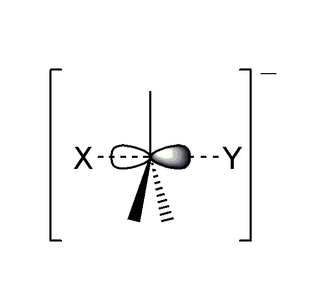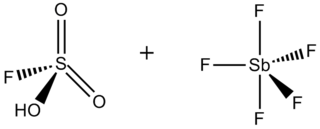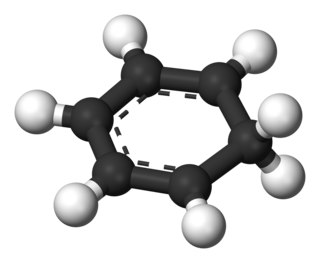Related Research Articles
A methyl group is an alkyl derived from methane, containing one carbon atom bonded to three hydrogen atoms — CH3. In formulas, the group is often abbreviated Me. Such hydrocarbon groups occur in many organic compounds. It is a very stable group in most molecules. While the methyl group is usually part of a larger molecule, it can be found on its own in any of three forms: anion, cation or radical. The anion has eight valence electrons, the radical seven and the cation six. All three forms are highly reactive and rarely observed.
In organic chemistry, Markovnikov's rule or Markownikoff's rule describes the outcome of some addition reactions. The rule was formulated by Russian chemist Vladimir Markovnikov in 1870.
In chemistry, a leaving group is a molecular fragment that departs with a pair of electrons in heterolytic bond cleavage. Leaving groups can be anions, cations or neutral molecules, but in either case it is crucial that the leaving group be able to stabilize the additional electron density that results from bond heterolysis. Common anionic leaving groups are halides such as Cl−, Br−, and I−, and sulfonate esters such as tosylate (TsO−). Fluoride (F−) functions as a leaving group in the nerve agent sarin gas. Common neutral molecule leaving groups are water and ammonia. Leaving groups may also be positively charged cations (such as H+ released during the nitration of benzene); these are also known specifically as electrofuges.

A carbocation is an ion with a positively charged carbon atom. Among the simplest examples are the methenium CH+
3, methanium CH+
5 and vinyl C
2H+
3 cations. Occasionally, carbocations that bear more than one positively charged carbon atom are also encountered.

The SN2 reaction is a type of reaction mechanism that is common in organic chemistry. In this mechanism, one bond is broken and one bond is formed synchronously, i.e., in one step. SN2 is a kind of nucleophilic substitution reaction mechanism, the name referring to the Hughes-Ingold symbol of the mechanism. Since two reacting species are involved in the slow (rate-determining) step, this leads to the term substitution nucleophilic (bi-molecular) or SN2; the other major kind is SN1. Many other more specialized mechanisms describe substitution reactions.

The Beckmann rearrangement, named after the German chemist Ernst Otto Beckmann (1853–1923), is a rearrangement of an oxime functional group to substituted amides. The rearrangement has also been successfully performed on haloimines and nitrones. Cyclic oximes and haloimines yield lactams.
The Friedel–Crafts reactions are a set of reactions developed by Charles Friedel and James Crafts in 1877 to attach substituents to an aromatic ring. Friedel–Crafts reactions are of two main types: alkylation reactions and acylation reactions. Both proceed by electrophilic aromatic substitution.
In chemistry, an electrophile is a chemical species that forms bonds with nucleophiles by accepting an electron pair. Because electrophiles accept electrons, they are Lewis acids. Most electrophiles are positively charged, have an atom that carries a partial positive charge, or have an atom that does not have an octet of electrons.

Dinitrogen pentoxide is the chemical compound with the formula N2O5, also known as nitrogen pentoxide or nitric anhydride. It is one of the binary nitrogen oxides, a family of compounds that only contain nitrogen and oxygen. It exists as colourless crystals that melt at 41 °C. Its boiling point is 47 °C, and sublimes slightly above room temperature, yielding a colorless gas.

Magic acid (FSO3H·SbF5) is a superacid consisting of a mixture, most commonly in a 1:1 molar ratio, of fluorosulfuric acid (HSO3F) and antimony pentafluoride (SbF5). This conjugate Brønsted–Lewis superacid system was developed in the 1960s by the George Olah lab at Case Western Reserve University, and has been used to stabilize carbocations and hypercoordinated carbonium ions in liquid media. Magic acid and other superacids are also used to catalyze isomerization of saturated hydrocarbons, and have been shown to protonate even weak bases, including methane, xenon, halogens, and molecular hydrogen.

A carbenium ion is a positive ion with the structure RR′R″C+, that is, a chemical species with a trivalent carbon that bears a +1 formal charge.

An arenium ion in organic chemistry is a cyclohexadienyl cation that appears as a reactive intermediate in electrophilic aromatic substitution. For historic reasons this complex is also called a Wheland intermediate, after American chemist George Willard Wheland (1907–1976). They are also called sigma complexes. The smallest arenium ion is the benzenium ion, which is protonated benzene.
In organic chemistry, the term 2-norbornyl cation describes one of the three carbocations formed from derivatives of norbornane. Though 1-norbornyl and 7-norbornyl cations have been studied, the most extensive studies and vigorous debates have been centered on the exact structure of the 2-norbornyl cation.

The helium hydride ion or hydridohelium(1+) ion or helonium is a cation (positively charged ion) with chemical formula HeH+. It consists of a helium atom bonded to a hydrogen atom, with one electron removed. It can also be viewed as protonated helium. It is the lightest heteronuclear ion, and is believed to be the first compound formed in the Universe after the Big Bang.

Distonic ions are chemical species that contain two ionic charges on the same molecule, separated by two or more carbon or heteroatoms. A feature of distonic radical ions is that their charges and radical sites are in different locations, unlike regular radicals where the formal charge and unpaired electron are in the same location. These molecular species are created by ionization of either zwitterions or diradicals; ultimately, a neutral molecule loses an electron. Through experimental research distonic radicals have been found to be extremely stable gas phase ions and can be separated into different classes depending on the inherent features of the charged portion of the ion.

In mass spectrometry, fragmentation is the dissociation of energetically unstable molecular ions formed from passing the molecules in the ionization chamber of a mass spectrometer. The fragments of a molecule cause a unique pattern in the mass spectrum. These reactions are well documented over the decades and fragmentation pattern is useful to determine the molar weight and structural information of the unknown molecule. Fragmentation that occurs in tandem mass spectrometry experiments has been a recent focus of research, because this data helps facilitate the identification of molecules.

In chemistry, ethenium, protonated ethylene or ethyl cation is a positive ion with the formula C
2H+
5. It can be viewed as a molecule of ethylene with one added proton, or a molecule of ethane minus one hydride ion. It is a carbocation; more specifically, a nonclassical carbocation.

The cyclopropenium ion is the cation with the formula C
3H+
3. It has attracted attention as the smallest example of an aromatic cation. Its salts have been isolated, and many derivatives have been characterized by X-ray crystallography. The cation and some simple derivatives have been identified in the atmosphere of the Saturnian moon Titan.
Hydrogen-bridged cations are a type of charged species in which a hydrogen atom is simultaneously bonded to two atoms through partial sigma bonds. While best observable in the presence of superacids at room temperature, spectroscopic evidence has suggested that hydrogen-bridged cations exist in ordinary solvents. These ions have been the subject of debate as they constitute a type of charged species of uncertain electronic structure.
Fulvio Cacace was an Italian chemist.
References
- 1 2 Fulvio Cacace (1964): Proceedings of the 1963 Conference on the Methods for Preparing and Storing Marked Molecules, Bruxelles, page 179. Euratom report EUR.1625.e.
- 1 2 3 4 5 6 7 8 9 10 Maurizio Speranza (1993): "Tritium for generation of carbocations". Chemical Reviews, volume 93, issue 8, pages 2933–2980. doi : 10.1021/cr00024a010.
- 1 2 Fulvio Cacace (1990): "Nuclear Decay Techniques in Ion Chemistry". Science, volume 250, issue 4979, pages 392-399. doi : 10.1126/science.250.4979.392.
- ↑ G. P. Akulov (1976): "Ion-molecular reactions initiated by β-decay of tritium in tritiated compounds" ("Ionn-molekulyarnye reaktsii, initsiirovannye β-raspadom tritiya v tritirovannykh soedineniyakh"). Uspekhi Khimii (USSR), volume 45, issue 2, pages 1970-1999. (No DOI).
- 1 2 Roger Vaughan Lloyd, Frank A. Magnotta, and David Eldon Wood (1968): "Electron paramagnetic resonance study of free-radical reactions initiated by radioactive decay in solid naphthalene-1-t". Journal of the American Chemical Society, volume 90, issue 25, pages 7142–7144. doi : 10.1021/ja01027a057
- 1 2 V. Lloyd and D. E. Wood (1970): "EPR Studies of 1-Naphthyl and 2-Naphthyl Radicals Produced by Tritium Decay". Journal of Chemical Physics, volume 52, pages 2153-2154. doi : 10.1063/1.167326952
- ↑ Cacace, Fulvio (1990). "Nuclear Decay Techniques in Ion Chemistry". Science. 250 (4979): 392–399. Bibcode:1990Sci...250..392C. doi:10.1126/science.250.4979.392. PMID 17793014.
- ↑ Ikuta, Shigeru; Yoshihara, Kenji; Shiokawa, Takanobu (1977). "Fragmentation by Beta-Decay in Tritium-Labelled Compounds, (III): Potential Energy Curves of LiHe+, BeHHe+ FHe+ Resulting from LiT, BeHT and FT". Journal of Nuclear Science and Technology. 14 (10): 720–722. doi:10.1080/18811248.1977.9730829.
- ↑ Appelman, E. H. (1973). "Nonexistent compounds. Two case histories". Accounts of Chemical Research. 6 (4): 113–117. doi:10.1021/ar50064a001.
- ↑ Nefedov, V. D.; Toropova, M. A.; Sinotova, E. N. (1989). Usp. Khim. 88: 883.
{{cite journal}}: Missing or empty|title=(help) as cited by Appelman (1973) - ↑ Fulvio Cacace, Giovanna Ciranni, and Angelo Guarino (1966): "A Tracer Study of the Reactions of Ionic Intermediates Formed by Nuclear Decay of Tritiated Molecules. I. Methane-t4". Journal of the American Chemical Society, volume 88, issue 13, pages 2903–2907. doi : 10.1021/ja00965a004
- ↑ Fulvio Cacace (1970): "Gaseous Carbonium Ions from the Decay of Tritiated Molecules". Advances in Physical Organic Chemistry, volume 8, pages 79-149. doi : 10.1016/S0065-3160(08)60321-4
- ↑ Fulvio Cacace and Pierluigi Giacomello (1973): "Gas-phase reaction of tert-butyl ions with arenes. Remarkable selectivity of a gaseous, charged electrophile". Journal of the American Chemical Society, volume 95, issue 18, pages 5851–5856. doi : 10.1021/ja00799a002
- ↑ Pierluigi Giacomello and Fulvio Cacace (1976): "Gas-phase alkylation of xylenes by tert-butyl(1+) ions". Journal of the American Chemical Society, volume 98, issue 7, pages 1823–1828.doi : 10.1021/ja00423a029
- ↑ Fulvio Cacace and Pierluigi Giacomello (1977): "Aromatic substitution in the liquid phase by bona fide free methyl cations. Alkylation of benzene and toluene". Journal of the American Chemical Society, volume 99, issue 16, pages 5477–5478. doi : 10.1021/ja00458a040.
- ↑ Marina Attina, Fulvio Cacace, Giovanna Ciranni, and Pierluigi Giacomello (1977): "Aromatic substitution in the gas phase. Ambident behavior of phenol toward t-C4H9+ cations". Journal of the American Chemical Society, volume 99, issue 15, pages 5022–5026. doi : 10.1021/ja00457a022.
- ↑ Fulvio Cacace and Pierluigi Giacomello (1978): "Aromatic substitutions by [3H3]methyl decay ions. A comparative study of the gas- and liquid-phase attack on benzene and toluene". Journal of the Chemical Society, Perkin Transactions 2, issue 7, pages 652-658. doi : 10.1039/P29780000652
- ↑ Marina Attinà, Fulvio Cacace, Giovanna Ciranni, and Pierluigi Giacomello (1979): "Gas-phase reaction of free isopropyl ions with phenol and anisole". Journal of the Chemical Society, Perkin Transactions 2, issue 7, pages 891-895. doi : 10.1039/P29790000891
- ↑ Marina Attina, Fulvio Cacace, and Pierluigi Giacomello (1980): "Aromatic substitution in the gas phase. A comparative study of the alkylation of benzene and toluene with C3H7+ ions from the protonation of cyclopropane and propene". Journal of the American Chemical Society, volume 102, issue 14, pages 4768–4772. doi : 10.1021/ja00534a032
- ↑ Fulvio Cacace, Giovanna Ciranni, and Pierluigi Giacomello (1981): "Aromatic substitution in the gas phase. Alkylation of arenes by gaseous C4H9+ cations". Journal of the American Chemical Society, volume 103, issue 6, pages 1513–1516. doi : 10.1021/ja00396a035
- ↑ Fulvio Cacace (1982): "On the formation of adduct ions in gas-phase aromatic substitution". Journal of the Chemical Society, Perkin Transactions 2, issue 9, pages 1129-1132. doi : 10.1039/P29820001129.
- ↑ Fulvio Cacace, Giovanna Ciranni, and Pierluigi Giacomello (1982): "Alkylation of nitriles with gaseous carbenium ions. The Ritter reaction in the dilute gas state". Journal of the American Chemical Society, volume 104, issue 8, pages 2258–2261. doi : 10.1021/ja00372a025
- ↑ Fulvio Cacace, Giovanna Ciranni and Pierluigi Giacomello (1982): "Aromatic substitution in the gas phase. Alkylation of arenes by C4H9+ ions from the protonation of C4 alkenes and cycloalkanes with gaseous Brønsted acids". Journal of the Chemical Society, Perkin Transactions 2, issue 11, pages 1129-1132. doi : 10.1039/P29820001129
- ↑ Marina Attina, and Fulvio Cacace (): "Aromatic substitution in the gas phase. Intramolecular selectivity of the reaction of aniline with charged electrophiles". Journal of the American Chemical Society, volume 105, issue 5, pages 1122–1126. doi : 10.1021/ja00343a009
- ↑ H. Colosimo, M. Speranza, F. Cacace, G. Ciranni (1984): "Gas-phase reactions of free phenylium cations with C3H6 hydrocarbons", Tetrahedron, volume 40, issue 23, pages 4873-4883. doi : 10.1016/S0040-4020(01)91321-3
- ↑ Marina Attina, Fulvio Cacace, and Giulia De Petris (1085): "Intramolecular selectivity of the alkylation of substituted anilines by gaseous cations". Journal of the American Chemical Society, volume 107, issue 6, pages 1556–1561. doi : 10.1021/ja00292a017
- ↑ Fulvio Cacace, and Giovanna Ciranni (1986): "Temperature dependence of the substrate and positional selectivity of the aromatic substitution by gaseous tert-butyl cation". Journal of the American Chemical Society, volume 108, issue 5, pages 887–890. doi : 10.1021/ja00265a006
- ↑ Fulvio Cacace, Maria Elisa Crestoni, and Simonetta Fornarini (1992): "Proton shifts in gaseous arenium ions and their role in the gas-phase aromatic substitution by free Me3C+ and Me3Si+ [tert-butyl and trimethylsilyl] cations". Journal of the American Chemical Society, volume 114, issu 17, pages 6776–6784. doi : 10.1021/ja00043a024
- ↑ Fulvio Cacace, Maria Elisa Crestoni, Simonetta Fornarini, and Dietmar Kuck (1993): "Interannular proton transfer in thermal arenium ions from the gas-phase alkylation of 1,2-diphenylethane". Journal of the American Chemical Society, volume 115, issue 3, pages 1024–1031. doi : 10.1021/ja00056a029